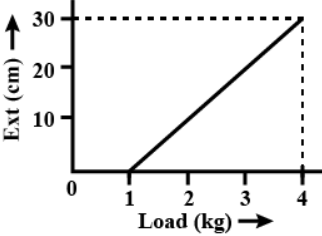
The pointer reading v/s load graph for a spring balance is as given in the figure. The spring constant is

(A)
(B)
(C)
(D)
Answer
138.9k+ views
Hint To find the answer, you first need to know that spring constant of a spring is nothing but the restoring force of a spring generated due to unit extension produced in the spring due to the external force applied on the spring. Mathematically,
You can use the graph to find the value of the spring constant very easily once you find the slope of the graph.
Complete step by step answer
As explained in the hint section of the solution to the question, we firstly need to know what spring constant is and how it is defined mathematically as relation of restoring force produced and the extension brought into the spring due to the force applied.
The spring constant,
Mathematically, spring constant can be given as:
Where,
If we observe the graph, we can see that the slop can be given as:
Where,
If we find the value of the slope of the slope, we need to substitute the values of ordinates and abscissas of the two chosen points as:
Also, since the y-axis is the extension in the spring while x-axis is the applied external force which is then gets nullified by the spring’s restoring force, the slope can also be taken as:
Where
Since the spring ultimately achieves equilibrium in each case, we can say that:
Thus, we can write the spring constant as:
Substituting the value of the slope of the line in the graph, we get the value of spring constant as:
As we can see, the correct answer to the question is option (A) since the value matches what we found out by solving the question.
Note Even though the value of force we took in the expression of spring constant and the slope turned out to be the same, remember that it would not be the same always. It was the same in our case as the spring was able to achieve equilibrium in each case and thus cancelled out the downwards force by the restoring force thus generated. Thus, the spring constant would not always be the same as the reciprocal of the slope of the graph.
You can use the graph to find the value of the spring constant very easily once you find the slope of the graph.
Complete step by step answer
As explained in the hint section of the solution to the question, we firstly need to know what spring constant is and how it is defined mathematically as relation of restoring force produced and the extension brought into the spring due to the force applied.
The spring constant,
Mathematically, spring constant can be given as:
Where,
If we observe the graph, we can see that the slop can be given as:
Where,
If we find the value of the slope of the slope, we need to substitute the values of ordinates and abscissas of the two chosen points as:
Also, since the y-axis is the extension in the spring while x-axis is the applied external force which is then gets nullified by the spring’s restoring force, the slope can also be taken as:
Where
Since the spring ultimately achieves equilibrium in each case, we can say that:
Thus, we can write the spring constant as:
Substituting the value of the slope of the line in the graph, we get the value of spring constant as:
As we can see, the correct answer to the question is option (A) since the value matches what we found out by solving the question.
Note Even though the value of force we took in the expression of spring constant and the slope turned out to be the same, remember that it would not be the same always. It was the same in our case as the spring was able to achieve equilibrium in each case and thus cancelled out the downwards force by the restoring force thus generated. Thus, the spring constant would not always be the same as the reciprocal of the slope of the graph.
Recently Updated Pages
Young's Double Slit Experiment Step by Step Derivation

How to find Oxidation Number - Important Concepts for JEE

How Electromagnetic Waves are Formed - Important Concepts for JEE

Electrical Resistance - Important Concepts and Tips for JEE

Average Atomic Mass - Important Concepts and Tips for JEE

Chemical Equation - Important Concepts and Tips for JEE

Trending doubts
JEE Main 2025 Session 2: Application Form (Out), Exam Dates (Released), Eligibility, & More

JEE Main 2025: Derivation of Equation of Trajectory in Physics

A point charge + 20mu C is at a distance 6cm directly class 12 physics JEE_Main

Learn About Angle Of Deviation In Prism: JEE Main Physics 2025

Electric Field Due to Uniformly Charged Ring for JEE Main 2025 - Formula and Derivation

JEE Main 2025: Conversion of Galvanometer Into Ammeter And Voltmeter in Physics

Other Pages
JEE Advanced Marks vs Ranks 2025: Understanding Category-wise Qualifying Marks and Previous Year Cut-offs

Degree of Dissociation and Its Formula With Solved Example for JEE

Electric field due to uniformly charged sphere class 12 physics JEE_Main

Dual Nature of Radiation and Matter Class 12 Notes: CBSE Physics Chapter 11

Formula for number of images formed by two plane mirrors class 12 physics JEE_Main

A conducting loop carrying a current is placed in a class 12 physics JEE_Main




